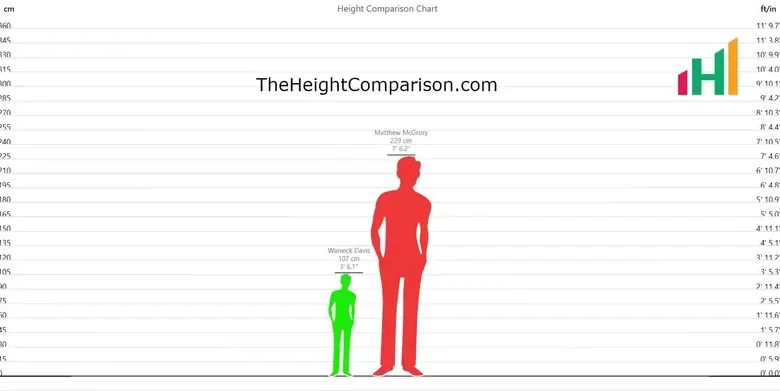Height Comparison Chart – Compare Heights Like Never Before
Jushify - https://jushify.com

Do you find yourself pondering over height comparison, curious about how you stack up against famous celebrities, or simply intrigued by the world of heights? Jushify’s Height Comparison Tool is here to satiate your curiosity and make exploring heights an engaging and enjoyable experience with the Height Comparison Chart.
Unveiling the Height Comparison Tool
At the heart of Jushify lies the Height Comparison Tool, an intuitive online platform that brings height differences to life. Whether you’re interested in comparing the heights of historical figures, visualizing the size of everyday objects, or planning home projects, this versatile tool is your key to unlocking a world of possibilities.
Comparing Heights
Comparing Heights is at the core of what we offer at Jushify. Our platform is designed to make height comparisons easy, engaging, and even entertaining. Whether you’re curious about how you measure up to famous celebrities, want to visualize the size of everyday objects, or need to plan home projects, Comparing Heights is a versatile tool that opens the door to a world of possibilities.
With a few simple steps, you can gather your measurements, input your subjects and objects, and let the magic happen. Our user-friendly interface ensures that Comparing Heights is a seamless and enjoyable experience, whether you’re engaging in practical measurements or simply having some fun with comparisons.
Height Comparison Chart
When you embark on your height exploration journey at Jushify, you’ll quickly realize the power of the Height Comparison Chart. This dynamic tool is the heart of our platform, serving as your visual companion for all things related to height. It’s here where measurements come to life, offering a clear and concise representation of the height differences you’re keen to explore.
The Height Comparison Chart, conveniently situated on our user-friendly interface, not only delivers accuracy but also provides you with the flexibility to customize your comparisons. Whether you’re comparing the heights of historical figures, visualizing the size of objects, or planning for practical projects, this chart is your go-to resource. It’s a feature that encapsulates the essence of Jushify, making height comparisons a seamless and enjoyable experience.
Height Difference
Exploring Height Difference is what sets Jushify apart. Our platform empowers you to delve into the world of heights, uncovering the fascinating disparities that exist between individuals, objects, and landmarks.
With our Height Comparison Tool, you can easily calculate and visualize Height Differences, making it an invaluable resource for a wide range of scenarios. Whether you’re keen on understanding how different historical figures measure up or you’re planning practical projects where height plays a vital role, Height Difference is the key that unlocks accurate and visual comparisons. It’s the tool that transforms numbers into meaningful insights, offering you a comprehensive view of height disparities.
Height Compare
At Jushify, we’re all about making Height Compare a breeze. Our user-friendly Height Comparison Tool takes the guesswork out of measuring and comparing heights, whether you’re interested in visualizing the difference between objects or assessing the height disparities between individuals.
Height Compare is more than just a feature; it’s a dynamic tool that streamlines the comparison process. By offering a straightforward interface and the ability to input various subjects and objects, we’ve made Height Compare a valuable resource for anyone, from homeowners planning renovations to individuals seeking to satisfy their curiosity about height disparities.
With a few clicks, you’ll be able to see the differences come to life, converting measurements into a clear visual representation.
Height Chart Compare
When it comes to Height Chart Compare, Jushify sets the bar high. Our platform goes beyond mere measurements; it offers you the ability to chart and compare heights in a way that’s both informative and visually engaging.
Height Chart Compare is where numbers transform into insights, allowing you to see the differences between subjects and objects with clarity. Whether you’re aiming to create a height chart for a home project or you’re interested in comparing the heights of various individuals, Height Chart Compare is your go-to tool.
With our intuitive interface, you can effortlessly create, customize, and visualize height charts that bring your comparisons to life. It’s a feature that empowers you to explore heights with precision and convenience.
Compare Heights
At Jushify, the ability to Compare Heights is at your fingertips. Our platform offers an innovative approach to comparing heights with ease. Whether you’re interested in comparing the heights of famous personalities, objects, or even planning your home renovation, Compare Heights is the feature that makes it all possible.
Our user-friendly interface ensures that you can effortlessly input your data, and within moments, witness the visual representations of height differences. It’s a powerful tool for both practical applications and satisfying your curiosity about how things measure up in the world of heights.
Height Difference Couples
Height Difference Couples are among those who can truly appreciate the unique charm of Jushify. If you’re part of a couple where the heights of both partners vary, our platform offers you an entertaining and insightful way to explore these disparities.
Height Difference Couples can use our Height Comparison Tool to visualize the differences in a fun and engaging manner. Whether you’re planning your wedding and need to figure out the best pairings or simply want to satisfy your curiosity, our platform is designed to cater to you.
It’s a valuable resource that provides a lighthearted way to compare heights and appreciate the individuality that height differences can bring to a relationship.
Unlocking the Power of the Height Comparison Tool
Understanding the Height Comparison Tool and making the most of it is a breeze. Here’s a step-by-step guide to help you unleash its potential:
Step 1: Gathering Your Measurements and Subjects
You can dive right into the world of height comparisons just for fun, but for accurate results, knowing the measurements and subjects involved is a must. If you’re unsure about an exact measurement, a quick online search or your best estimate will work just fine.
Step 2: Entering Your Data
The Height Comparison website offers a sleek and organized design, making your experience a delightful one. On the main page, you’ll find two rectangular panels, one for human subjects and the other for objects.
For human subjects, you can get creative by customizing their gender and name, and then enter their height in feet or centimeters. What’s more, you can even select a color to represent them on the comparison chart. Once you’ve filled in these details, hit the “+ Add Person” button, and they’ll appear on the chart, ready for comparison.
The Add Object panel is your gateway to comparing objects such as a closet, door, car, couch, or geometric shapes. No need to press an “Add” button here; just select the object you desire, and it will instantly appear on the chart. If you’ve opted for geometric shapes like circles or rectangles, you can further customize their size.
Pro Tip: Adjust the size and height of circles and rectangles by selecting their respective panel on the top-left side of the chart.
Should you want to remove an object from the chart, a simple click on the close button next to the object’s title will make it vanish, much like closing a web page. The Height Comparison Chart provides results in both centimeters and feet and inches, ensuring you have all the measurements you need.
Step 3: Compare, Plan, and Have Fun!
With your subjects and objects now displayed on the chart, you’re all set to embark on your height comparisons. The Height Comparison Tool takes care of the number crunching, automatically converting measurements between centimeters and feet, ensuring accurate and reliable results.
Why Use Jushify?
The possibilities are limitless. Are you planning a home improvement project, moving furniture, or contemplating a remodel? The Height Comparison Tool can be your trusted companion to measure and visualize your design ideas.
Perhaps you’re in the midst of planning a wedding and wondering how to pair bridesmaids and groomsmen effectively. Gathering their heights and comparing them using our crisp and clear chart will simplify the task and ensure a visually harmonious bridal party.
However, this tool isn’t solely for practical purposes. You can also indulge in a bit of nerdy fun, comparing your height to iconic landmarks like the Great Pyramids of Egypt. The tool can measure heights up to 20,000 meters, opening up endless opportunities to visualize your imagination.
Here at Jushify, we’re not just about measurements; we’re dedicated to offering a fully customizable, stress-free, and enjoyable experience. We understand that height comparisons can serve practical and entertainment purposes, and we’ve crafted our tool with your needs in mind.
Conclusion: The Height Comparison Chart
Jushify is your one-stop destination to explore the world of heights like never before. With user-friendly features, versatility, and the ability to provide measurements in both centimeters and feet, it caters to a diverse range of users and purposes.
Discover the heights of the world, enjoy fun comparisons, and embark on practical projects with confidence. Your curiosity is only a click away from being satisfied. Visit Jushify today and embark on a journey of heights like never before.
Read other articles:
What is Image Compression in Digital Image Processing?





